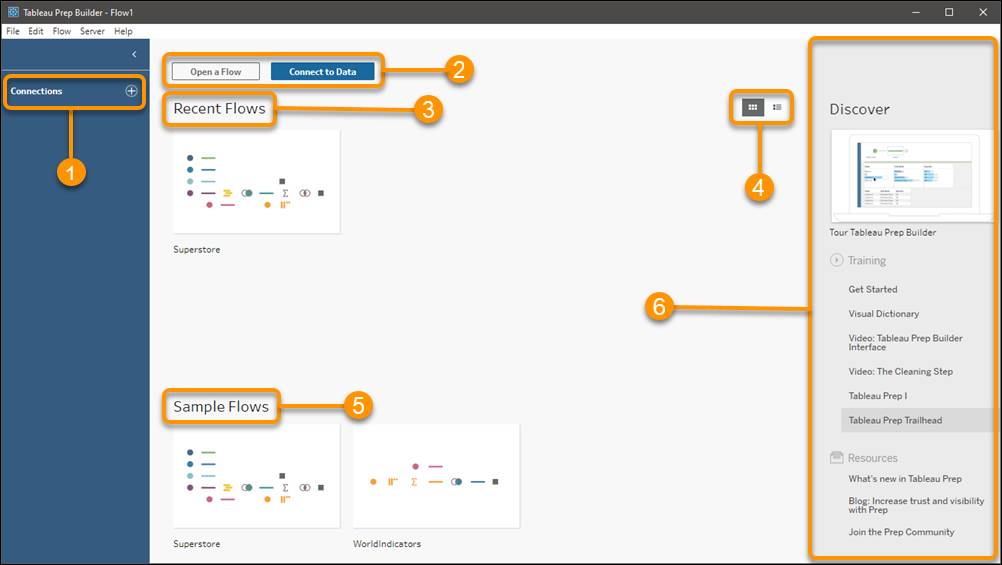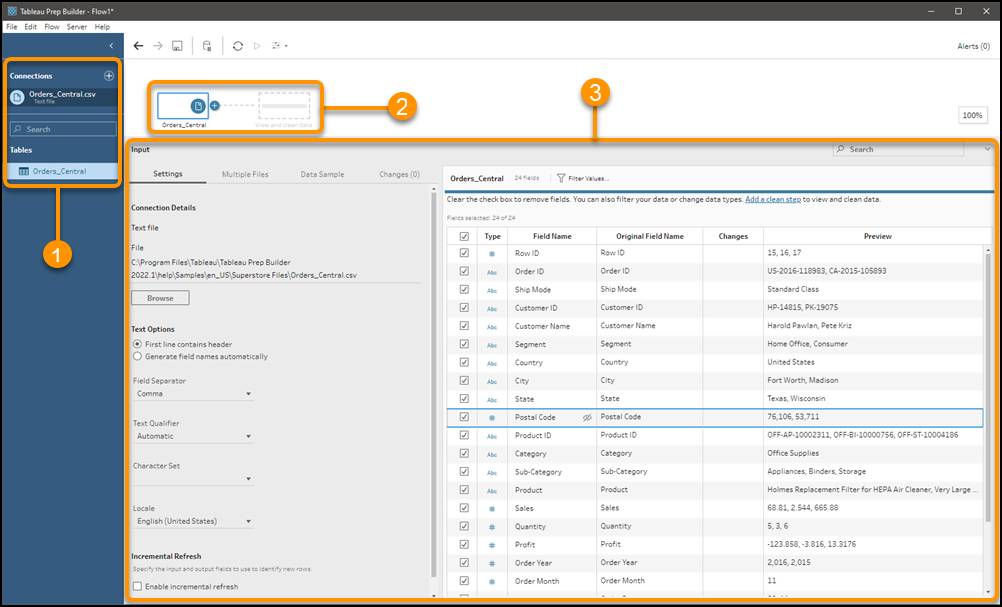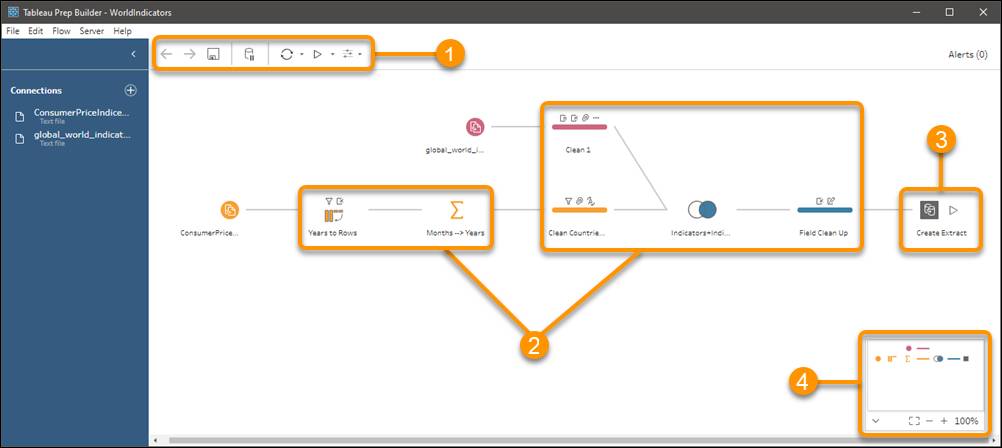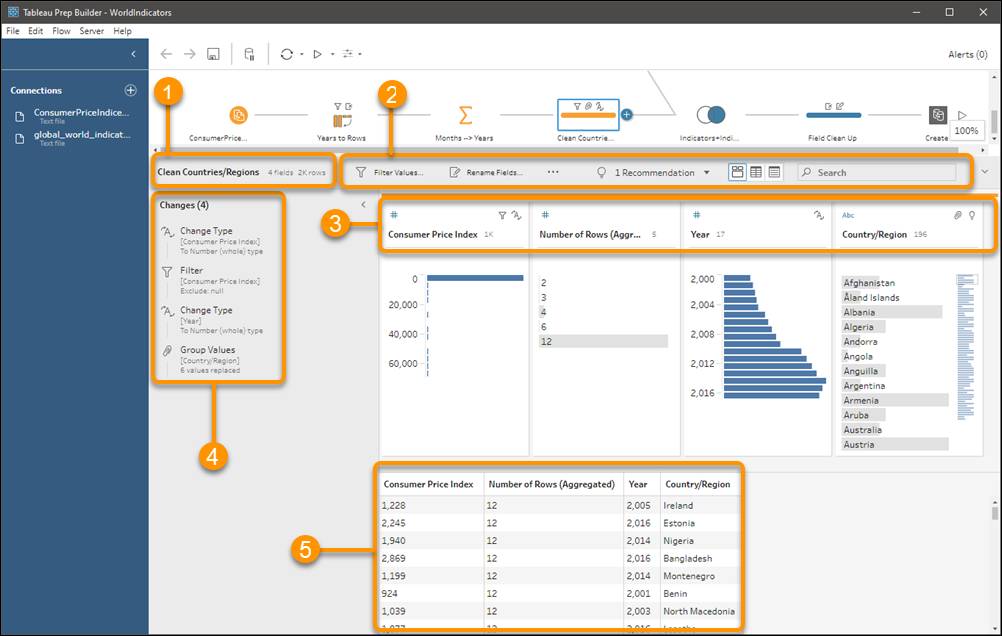Explore the Tableau Prep Environment
Learning Objectives
After completing this unit, you’ll be able to:
- Identify the areas of the Tableau Prep workspace.
- Describe the purpose for each of the workspace components.
Explore the Tableau Prep Workspace
The Tableau Prep workspace provides a visual and direct way to see and interact with every step of the data preparation process. Connect to data from the Start page, configure data from the Input pane, create and organize your data prep steps in the Flow pane, and clean your data using the Profile pane and data grid.
Start Page: Connect to Data and Open Flows

- Connections (1) Connect to your data sources, such as published data sources on Tableau Server or Tableau Cloud, Flat files, including .csv or .xlsx files, and databases using a number of native connectors or JDBC or ODBC connectors.
- Open a Flow or Connect to Data (2) Connect to data sources or open an existing flow.
- Recent Flows (3) Access your most recent flows and works in progress.
- Recent Flows toggle (4) View Recent Flows as a list or as icons.
- Sample Flows (5) Access sample files and flows included with the Tableau Prep installation.
- Discover pane (6) Find training material and resources on the Discover pane.
Connections and Input: Configure Data

- Connections pane (1) After you connect to a data source, the Connections pane shows you the input files you selected and their associated tables.
- Input step (2) When you connect to a single table, an input step is automatically added to the Flow pane. If you connect to a database or multitable file, add input steps to the flow by dragging the table(s) you want to work with from the Connections pane to the Flow pane.
- Input pane (3) After connecting to data, access configuration options from the tabs in the Input pane. On the Settings tab, configure the way Tableau Prep Builder deconstructs (or parses) the text in the file. On the Multiple Files tab, specify whether to use the single table selected in the Flow pane as the data source, or to combine multiple, similarly structured files with a wildcard union. On the Data Sample tab, set options for sample size and methods for sampled data.
Flow Pane: Create and Organize Your Data Prep Steps

- Flow menu toolbar (1) Provides shortcuts to save your packaged flow locally, pause updates to the flow, refresh the data, run the flow, or create parameters users can specify when running the flow.
- Flow steps (2) Represent a variety of data preparation options performed in the flow, including clean, join, union, aggregate, pivot, and more. Decide which operation to perform, and add the corresponding step to the flow to initiate it.
- Output step (3) Allows you to configure your flow output and then run your flow to create an output that contains the data with your preparation actions applied. You can generate the prepared output as a file, a published Tableau data source, or a database table.
- Flow navigator (4) Helps you navigate large flows more easily by visually representing the whole flow. On its toolbar, you can collapse or expand the navigator, change the size of the flow, or zoom in and out of desired areas of the flow.
Profile Pane and Data Grid: Clean Your Data

- Step name (1) Corresponds with the step you selected in the Flow pane, and shows the number of fields and the number of rows in your data at that step. It also displays a Sampled Indicator when data is sampled.
- Toolbar (2) Depending on the selected step, provides shortcuts for filtering, creating calculated fields, and more.
- Profile cards (3) Show information about the structure of the data at the selected step. In a cleaning step, each Profile card provides a visualization that helps you understand each field’s distribution, or how often values occur in that field. Use Profile cards to see the shape of your data, find outliers, spot relationships between fields, and so on. Values in Profile cards display in either Detail view, to show all unique values, or Summary view, to show value distributions in bins. Toggle between these views for numeric and date fields. String fields are shown only in the Detail view.
- Changes pane (4) Provides an interactive record of the changes you make in each step. Click on a step in the Flow pane to review the changes you made during that step. In the Changes pane, you can also copy, remove, and add descriptions to previously made changes, and you can edit certain changes.
- Data grid (5) Shows the row-level detail of the data which is highlighted to correspond with selected fields in the Profile pane and filtered to correspond with selected values in the Profile pane.
Tableau Prep Builder offers an easy and intuitive user interface that helps you optimize data for analysis. Now that you know your way around the environment, let’s move on to cleaning and shaping data.